Official Name
The Romanian name is Bucureşti. Note that 'ş' is read as [ sh ], so the pronunciation would be 'Bookooreshtee'. The German name is Bukarest; the common English name Bucharest. Legends say that a shepherd called Bucur lived here. The name means something like 'joy'. It is said that he founded the town. His grandchildren were called 'Bucuresti', and so it's got its present name.
Location

| ||
| Bucharest |
Roughly speaking between the Danube and the southern edge of the Carpathian mountains. Bucharest lies in the heart of Wallachia, which is dominated by rolling hills and some smaller lakes here and there. The small river Dâmboviţa flows through the town.
Population
About 2.3 million. Thus, Bucharest is by far the biggest town in Romania.
Orientation
At the beginning of the 19th century, Bucharest was also known as the Paris of the East. Well, that was a long time ago. The flattering comparison probably referred to the green and wide boulevards of the town and several beautiful buildings. Here and there, traces of the former glory can still be seen, but in wide parts it's just a smoggy, dirty chaos. The traffic is life-threatening. A green light at the pedestrian's doesn't mean that you can cross the road safely - au contraire, pedestrians seem to be legitimate prey. Somewhere else, this is called survival of the fittest.

| ||
| Stray dogs are everywhere... |
The town can be divided into several parts. There's even something like an old town centre stretching between the National Opera, Revolution Square, Cişmigiu Park and Unification Square (Piaţa Unirii). Large parts of the old town centre are under reconstruction. Generally there's a lot of construction work going on in the centre, so in a few years things might look much better. Recently, many expensive boutiques and fine restaurants are mushrooming everywhere. Obviously, Bucharest is booming. The parts to the north and the south are characterized by insane urban development à la Ceauşescu - masterpieces of megalomania. See below to read more about. Furthermore there are mainly dull, grey and dirty suburbs. The suburbs start already north of Gara du Nord (north terminal). Rumours say that some visitors love the city. For me, this is hard to believe. By now it's just a dull big town. However, it's true that Bucharest is in transition and might become a much more pleasant town.
One of Bucharest's attraction is the vast number of stray dogs. It's not that it's boring - there are fat and slim, tall and small, grey and colourful, sometimes three-legged and other types of dogs. And they often come in packs. The good news is that (almost) all of those flea-catchers show great respect for two-legged living beings. They just run away or lie around apathetically.
History
As already mentioned above, legend says that the town was once founded by the shepherd Bucur. During the reign of Vlad Tepes, Bucharest was granted urban rights (1459) and became the capital of Wallachia. It was not before 1861 that it was declared capital of Romania. The town grew quickly and became quite popular. Things changed when Ceauşescu took over and started to realize his understanding of modern urban development. Several complete residential areas fell victim to the slightly Stalinistic urban development (hence the stray dogs - the owners had to leave and didn't know where to go and whether they can take with the dogs). Old residential areas were substituted by giant palaces and other buildings. Here and there, a Romanian-Orthodox church was left, reminding the visitor of where he is: Not in Russia, but in the Balkans.
Bucharest played a very important role in the revolution, which took place in 1989. This included heavy street fights and outraged miners trying to march on the heart of the capital twice. Today, Bucharest is a boomtown and a gauge indicating the gradually improving economy of the country. However, Bucharest does not really represent the country: No place in Romania looks like or similar to the capital.
Getting there / transportation
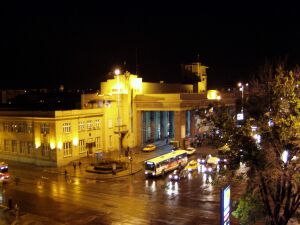
| ||
| Gara du Nord - the North Terminal of Bucharest |
For more information on how to get to Romania and its capital, see →Travel information Romania. Most of the long-distance trains arrive at the Gara du Nord, which is a few kilometres west of the old town. Safety around the train station is questionable. There are other train stations, mainly used for local trains. One of them is the Gara Basarab (Bessarabian terminal), from where trains to the west and to the south depart. This station is interesting for those who want to go to →Bulgaria on a local train. The station is easy to find - just follow the road left of Gara du Nord for a few hundred metres.
One of the very few useful projects initiated by Ceauşescu's was the construction of the Metrou (subway). There are three lines, the carriages and the stations are clean and modern. It's the best and fastest way to get around in Bucharest. One ticket is good for two rides and costs 0.8 Lei. Additionally, the town is well served with trolleybuses, trams and buses. And countless taxis. The standard fare for most routes within the town is 4 Lei.
Safety
Bucharest has a rather bad reputation regarding safety in public. Fake policemen, theft and more are not seldomly heard of. As in any other European metropolis, common sense should do, ie never show your passport and/or money to someone you don't know. If it's a policeman (or someone who looks like he could be one), insist on being accompanied to the next police station etc. Check if there's a meter and if yes, whether it's switched on, before you opt for a taxi.
However, one thing is for sure: The area around Gara du Nord is not safe!!! At night and sometimes even during the daytime, gangs of glue-sniffing kids loiter in the area around the train station (as we could see from our hotel room every day). Not the perfect place for a nocturnal walk.
Compared to other European capitals, there aren't so many "must-see" sights in Bucharest. It's more about the general impression. Unfortunately, the unique atmosphere of the old town was sustainably destroyed by the socialist urban development. One of the famous places in town include the Arcul de Triumf (Triumphal Arch) in Northern Bucharest, which is dedicated to the victims of World War I.

| ||
| Typical scene in Bucharest |
Other important historic buildings include the Catedrala Patriarhalâ (Archbishop's Cathedral) and Curtea Veche (ruins of the old Royal Palace). Between all these goodies, visitors will most likely be impressed by scenes as on the picture to the right: Pure traffic chaos in streets which are either too narrow or too wide and a strange mixture of old, crumbling buildings, new and dull buildings and many large gaps, which have been taken over by impressive weed habitats. Of course, places like these can be found everywhere, but in Bucharest it's more than usual. Unfortunately, it was raining almost all the time when we were in town, so things looked much worse than they usually do.
For many visitors, the main attraction of Bucharest appears to be the huge Casa Poporului (Palace of the People), which is today known as the 'Palace of Parliament'. This giant structure dominates the southern part of the city and is the masterpiece of Ceauşescu's Centrul Civic, Next to the palace there's a large and rather bleak park. A massive wall surrounds the palace, probably in order to keep the people away from their palace. Construction work started in 1984 following orders from the president Ceauşescu. Around 20,000 workers were busy realizing the plans of 700 architects. Amazingly enough, the chief architect was a very young beginner - at that time, the woman was around 25 years old, and the palace was her first commission. People might think whatever they want when they see the monstrosity, but it's a architectural masterpiece.
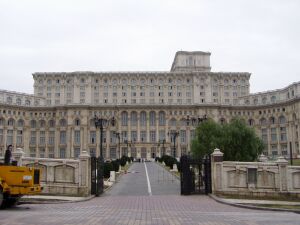
| ||
| Side entrance (!) of the Palace of the People |
At the time Ceauşescu was swept away by the revolution, ie in 1989, only about 70% of the palace were completed. Some people voted for the destruction of the palace, but this would have been completely useless (and expensive), and so politicians decided to continue. Today, around 90% are completed. Except for the technical equipment, exclusively Romanian material is used - including tons of the finest Romanian marble in different shades and colours and lots of crystal for the dozens of chandeliers. In surface, it's the second-largest building in the world - No 1 is the Pentagon. In Volume, it's the third-largest, coming right after the Pentagon and...I've forgotten about the other one. Nowadays, it is used by the Romanian parliament, for congresses and partially as a museum. The nice young lade guiding us through the palace told us a story: The front of the building is characterized by a large, splendid balcony with a huge square in front of the building. Obviously, it was Ceauşescu's intention to address his people from the balcony. Well, the flying execution squad was faster. The one and only person having the honour of talking to masses from the balcony was Michael Jackson - he started his speech with a hearty "Hello BUDAPEST". What a...
Getting there: Take the metro to the station Izvor or the bus/tram to Piaţa Unirii and walk the rest - it's impossible to miss the palace. Visitors can only enter the palace through the southern side entrance - the right southern entrance, to be exactly.
Admission fee: Foreign visitors pay 10 Lei (€ 3, Romanians pay 5 Lei, Students 3 Lei), a photo permission costs an extra 9 Lei. The admission fee includes a tour in English. It's not allowed to explore the palace on your own. The whole tour takes around 45 minutes. It's only possible to see a small part of the building.
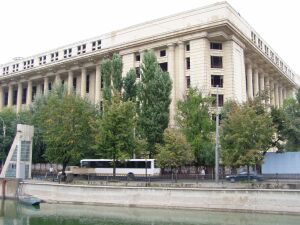
| ||
| One of many uncompleted buildings |
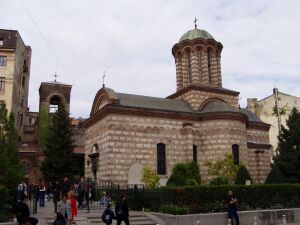
| ||
| Near Curtea Veche: The old Bucharest |
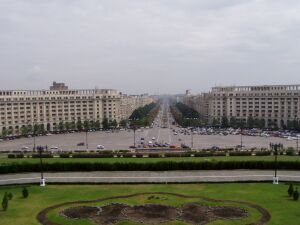
| ||
| Ceauşescu's idea of a perfect metropolis |
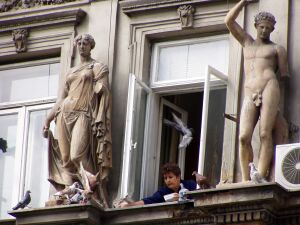
| ||
| Poisoning pigeons ...? |
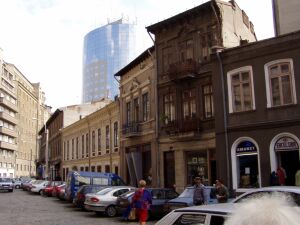
| ||
| Old and new - almost like a Fata Morgana |
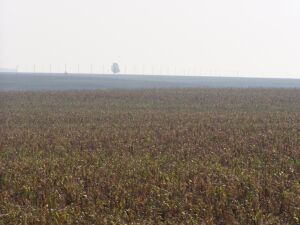
| ||
| In the middle of nowhere: Wallachia |
There's not so much to see near Bucharest - the area around the capital is part of the historical district Wallachia and consists of mainly flat land and endless fields. By the way, in German 'Wallachia' (here: Wallachei) is a synonym for 'in the middle of nowhere'. You will understand why once you are there. Around 40 km north of Bucharest, there's the small but historically important town of Snagov. There you can see a church, a monastery and the tomb of Vlad Tepes, also known as Dracula's tomb. Don't go there between dusk and dawn...
Some 100 km south of there's Giurgiu (pronounced jur-jou) - a large industrial town close to the river Danube. It makes a good base for crossing the border, since →Ruse on the other side of the river (→Bulgaria) is not far. There's not much to see in the town itself, and as you can see on the picture, there's also not much to see on the way to Giurgiu. There seems to be no direct local train, so it's necessary to change trains in Videle. Shortly before arriving in Videle you will notice several old-fashioned derricks - yes, Romania produces its own crude oil. Not enough but...
From Giurgiu, you can cross the longest steel girder bridge in Europe spanning the river Danube resp. the Bulgarian-Romanian border. It's a long walk from the centre of town to the bridge, so you might want to hire a taxi. Most locals trains - also the one from Videle - terminate at Giurgiu Nord, which is even further away from the border.
There are countless hotels in town - fleapits as well as luxury hotels. Some are located in the centre, others are far away from it all. If you travel by train and don't have the intention to stay an eternity in Bucharest, it's quite convenient to stay in one of the hotels concentrating around Gara du Nord. Walk out the station, turn right, cross the first street and you will find yourself standing in front of Hotel Cerna. A double costs 80 Lei per night, which is € 10 per person. Toilet and bathroom are shared. The hotel is clean and the service appropriate. The only drawback to it is the fact that the area around the train station is not very safe at night. Address: Blvd Golescu 29, Tel.: 637 40 87.
- www.romania4you.com A good place to look for restaurants, hotels and more. In English.
- www.pmb.ro The official website of Bucharest. Maybe the English version will be ready some time?
Do you have or do you know a good website about Bucharest? Don't hesitate, let me know! After checking it, I would love to add it to the link list. You can submit a link by using the →contact form. Note that commercial websites will be treated differently.
©2024 Europe-East.com

 Albania
Albania Romania
Romania